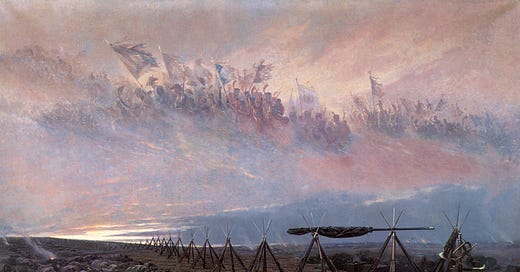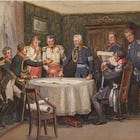In the spring of 1911, La Gazette de l’Armée published, in four pieces, an article on the subject of war games of the type played at that time in the armies of the German Empire. The following text translates the fourth part of the essay, which, I am happy to say, proved far less elusive than the previous installments in the series.
The Kriegspiel Meeting
It is a good idea to conduct relatively few games, so that you might do a better job of running each exercise. Thus, we should content ourselves with two or three Kriegspiel meetings at a center of instruction.
Many make the mistake of thinking that playing many games will provide players with a stock of solutions for all situations. This cannot be. The situations that present themselves in war take an infinite variety of forms, we can make up far more than we will ever see. Moreover, one does not play with men as one does with dice. Finally, the first shot fired in anger will often kill things that have been memorized.
Therefore, this is what we ought to do. First, train the brain to make rapid, reasonable decisions; to shed light on a concept, to set a goal. Second, teach yourself to develop the reflexes that allow you to operate independently for a period of time. In addition, it is better to visit, and revisit, a situation rich in lessons than to muddle through many scenarios.
Put the Players Under Pressure
A locomotive warms up for close to two hours before it begins to move. For a brain, such preparation varies considerably, but often requires several days and several nights. In order to understand the painful fermentation, the hopeless chaos that one must experience before achieving a degree of clarity about a given issue, one must have concentrated his faculties of mind upon the study of a somewhat difficult problem. Some think that, as war is full of unforeseen circumstances, a leader of men ought to have a brains that can make instantaneous decisions. As soon as a problem appears, a solution pops up. This type of man does not exist.
An axiom of mechanics states that, when something gains speed, it looses force. In war, the art consists less in the making of a quick decision than in finding, despite events, the time to reflect. The commander who parries with precision seemingly unexpected thrusts is generally a man ‘on guard’ who has foreseen the maneuvers. As the regulation prescribes, ‘he has used all available means to orient himself to the situations faced, and movements made, by neighboring units and has imagined in his mind all of the measures that he might take to counter eventualities that might occur.’ (R.M. art. 251)1
On the battlefield, the gravity of events puts us under pressure. In training, we replicate this effect by immersing ourselves in a scenario that sets up the drama in which we will soon play a part and by using our imagination to hide the fact that the drama is a work of fiction.
This requires two things:
That the scenario be as realistic as possible, which is why nothing is better than events that took place in recent wars.
That the scenario be passed out in advance, not merely to the player who plays the role of the commander, but to all involved in the Kriegspiel.
This is not to say that one should provide players with a script that allows them to show up with orders that they wrote in their rooms. This way of doing things will only irritate the ability that we exercise during the game, the ability to see things both thoroughly and quickly.
If we limit our Kriegspiel exercises to one time each year; if we devote our best efforts to the meeting itself; if we write up, and distribute, for the benefit of all, written descriptions of the good ideas we discovered, then the motivation and self-regard [amour-propre] will work wonders.
Make Everyone Work
With a few rare exceptions, the only player who works during a Kriegspiel is the commander [of the task force on the map]. The [player commanding the] cavalry brings important information. The director asks for decisions.
The commander has no need to read out the information he has received. He makes a decision and gives an order to the officer commanding Battalion N, who does the same.2
The answer given to the director is not anonymous. It consists of two or three orders, written out and signed, which give each player his mission and the degree of discretion he is allowed. It is a game of ‘little papers’, but we cannot avoid doing it. The actors in the drama are not to imagine themselves as part of a group, but as located on different places on the map.
This does not, however, prevent the use of quiet moments for instruction, for examining, under the watchful eyes of the commander, the decisions made.
We have spoken of quiet moments. In a Kriegspiel, with two teams and one director, such breaks in the action cannot be avoided.
These long, repeated pauses do much to extend the length of games, to tire out players, and put them to sleep.
We might therefore ask ourselves if we might not be better off with one-sided map problems, which eliminate this fault and produce, in a given amount of time, a much larger number of ideas.
At any rate, when taking part in a two-sided exercise, the commander [of each team] should make use of pauses to skillfully kept the attention of other players focused on the decisions that have been taken. Likewise, the director, well-equipped and well-assisted, should quickly, and with great energy, trace the logical consequences of decisions made.
So much for the Kriegspiel.
The Blanket (or, the War Game for Newbies)
This game is not new. Indeed, it has so often been abused, it has become an object of ridicule. Some of us have seen soldiers gather around a blanket, where green beans represented a network of sentry posts and the grabbing of two pods indicated the removal of a sentry.
A blanket can easily depict, quickly and on a large scale, any sort of terrain. Rags under the blanket [make hills], some blue and white ribbons serve as rivers and roads, and, if one wants to go to town, he can make bell towers, windmills, and little houses out of cardboard, hedges out of paper. In this way, material that costs nothing does a better job of representing terrain than curves and hashmarks [on a map]. The scale (between 1:1,000 and 1:2,000) suffices to study both ends of a fire fight, as well as to play with patrols, squads, sections, and platoons. (This cannot be done with a 1:8,000 map, even with the help of a magnifying glass.)
A final word. Don’t devote too much time to war games of any kind. Nothing can replace field work, especially for the youngsters who need to spend time out-of-doors.
C’est tout (which is French for ‘that’s all, Folks!’)
Source: Anonymous: ‘le Jeu de la Guerre’ la Gazette de l'Armée (11 May 1911)
For Further Reading:
My search for ‘RM art. 251’, which I presume means Règlement Militaire or Règlement de Manoeuvre article 251, yielded nothing.
The ‘N’ in ‘Battalion N’ seems to stand for numero [number].











“Some think that, as war is full of unforeseen circumstances, a leader of men ought to have a brains that can make instantaneous decisions. As soon as a problem appears, a solution pops up. This type of man does not exist.” So much for the famous coup d'oeil?